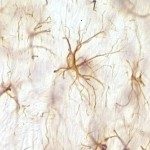Link to Pubmed [PMID] – 19597828
Acta Neuropathol. 2009 Nov;118(5):685-95
Camelids produce antibodies made of homodimeric heavy chains, and the antigen-binding region being composed of a single domain called VHH. These VHHs are much smaller than complete IgG. They are also more thermostable and more soluble in water; they should, therefore, diffuse more readily in the tissues. VHHs, expressed in bacteria, are easier to produce than conventional monoclonal antibodies. Because of these special characteristics, these antibody fragments could have interesting developments in immunohistochemistry and in the development of biomarkers. To test the possibility of their use in immunohistochemistry (IHC), we selected the glial fibrillary acidic protein (GFAP), a well-known marker of astrocytes. One alpaca (Lama pacos) was immunized against GFAP. Lymphocytes were isolated; the DNA was extracted; the VHH-coding sequences were selectively amplified. Three VHHs with a high affinity for GFAP and their corresponding mRNA were selected by ribosome display. Large quantities of the recombinant VHHs coupled with different tags were harvested from transfected bacteria. One of them was shown to immunolabel strongly and specifically to GFAP of human astrocytes in tissue sections. The quality of the IHC was comparable or, in some aspects, superior to the quality obtained with conventional IgG. The VHH was shown to diffuse on a longer distance than conventional monoclonal antibodies in fixed cortical tissue: a property that may be useful in immunolabeling of thick sections.


